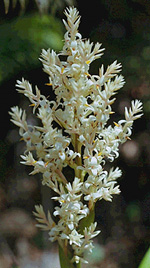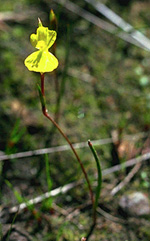 |
This small family is restricted to the western Pacific rim, extending from Australia through SE Asia to Japan, in swamps, fringing streams or in other places with permanently moist soil.
Characteristic features of the family Phylidraceae in Australia include: - annual or perennial herbs with erect, linear or sword-shaped leaves arranged in two rows
- flowers arranged in spikes or panicles, white, yellow or pink, distinctly zygomorphic with four perianth parts
- stamens one per flower
- ovary superior, of 3 fused carpels developing into a capsular or berry-like fruit
Description
Perennial terrestrial herbs. Perennating by corms or rhizomes. Internal secretions not obvious. Plants glabrous, or with simple, non-glandular, unicellular or uniseriate hairs. Leaves alternate and spiral, or distichous, all or mostly basal, sessile. Stipule-like lobes absent. Lamina simple, symmetric, filiform, acicular, subulate or linear; base attenuate; margins entire, ±flat; venation parallel, with the midrib inconspicuous, and the tertiary venation not reticulate; surfaces not punctate; herbaceous or leathery. Leaf ligule absent. All the flowers bisexual. Inflorescences terminal, consisting of spikes. Bracts absent. Bracteoles present. Pollination by insects. Flowers odourless or fragrant, sessile. Floral disc present; nectaries absent. Perianth irregular, of 2 ±similar whorls, with 4, free, petaloid segments, imbricate in bud, white, yellow or pink, without contrasting markings, membranous; claws absent; lobes ±entire, or adaxial shallowly 3-toothed. Fertile stamens 1, free of or at least partly fused to the perianth segments, free of the ovary and style. Filaments distinctly flattened. Anthers dorsifixed, versatile or not versatile, opening outwards or inwards by longitudinal slits, 2-celled. Ovary superior and sessile. Carpels 3, fused with each other; ovary with 1 or 3 locules. Style terminal, single and unbranched, or single and branched above. Ovules 15–numerous per locule, sessile; placentation parietal or axile. Fruit a dry, irregularly dehiscent, septicidal or loculicidal capsule; the perianth on the maturing fruit rotting or liquefying, or dry and persistent. Disseminule micro-surface ±alveolate or finely striate, brown or grey, glossy or dull. Seeds 15–numerous per fruit. Aril present or absent. Cotyledons 1. Embryo straight.
(Note: this description has been generated from the coded data compiled for the key. Any errors in the key data will be reflected in the descriptions.)
A treatment of the family Philydraceae has been published in:
Flora of Australia 45: 40-46.
Australian genera of Philydraceae (as recognised for the Flora of Australia)
Helmholtzia
Philydrella
Philydrum

|
  |

Helmholtzia acorifolia (flowers)
Photo: M.Fagg © M.Fagg

Helmholtzia glaberrima (flowers)
Photo: C.Green © ANBG

Helmholtzia glaberrima (flowering plant)
Photo: H.Nicholson © H. & N. Nicholson

Philydrella pygmaea (flower)
Photo: M.Fagg © M.Fagg

|
 |
|